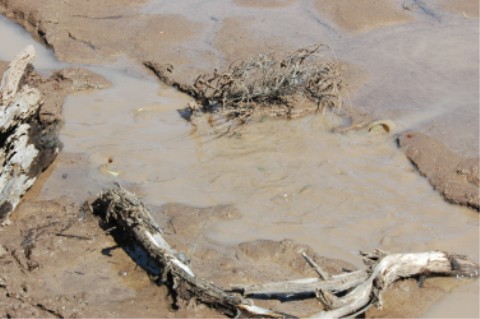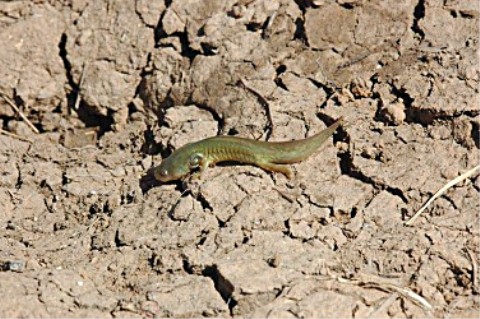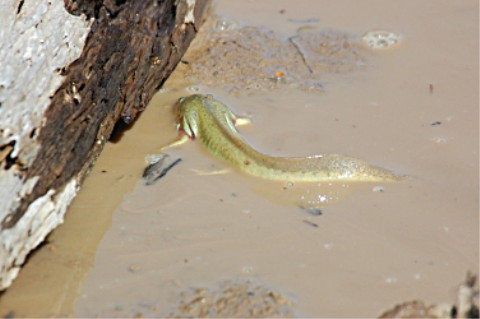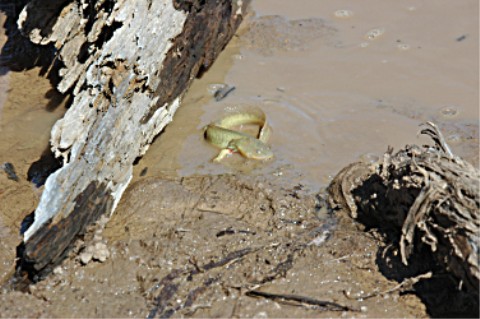
TIGER SALAMANDER
birdfotos.com

**********************************************************************
TID-BITS
03-06-06
****************************************************************
Wanting to get out of the extremely dry and polluted air of the Phoenix area
I headed north toward the Grand Canyon's South Rim and the COCONINO PLATEAU.
I don't know which is worse, the polluted Phoenix air; or all of the tourist at the South Rim of the Canyon :-)).
Therefore on this trip I decided to spend time driving the dirt roads in the forest just south of the
Canyon's South Rim and just South of Tusayan a few miles off State route 64 and then West on road 306.
I was told to check out the TANKS. HUMM, tanks,
I started looking for metal tanks with water in them. I didn't know if they
meant big tall round metal tanks or low open top tanks with water in them.
Much to my surprise neither of the above tanks were correct.
I soon found out that a tank up here is no more than a big scraped out hole in the ground
to hold run-off water from the rains and snow melt.
I guess a tank could be anything that held something, thus qualifying a large
depression in the ground no matter how it got there as a TANK.
Many of the tanks were dry, parched, cracked dirt, and no water.
This also meant no wild life would be coming to drink so I kept on driving.
Some of the tanks were numbered and some named as you will see.
After several hours of being driven around with by my friend Don we came across this tank
with a smidgen of damp mud in the bottom of the hole, well, maybe just a bit more than a smidgen.
Inasmuch as there was no water any where else we started to see birds immediately coming in to drink.
Get out those cameras and let's start taking photos I said as I jumped out of Don's vehicle almost before it had stopped.
Inasmuch as there no water any where else we started to see birds immediately coming in to drink.
And this is what it called

******************************************************************
ARIZONA TIGER SALAMANDER
Neoteny. Some populations of Tiger Salamanders, particularly in western North America and especially at high altitudes tend to be neotenic. This means that although the salamanders become sexually mature and can reproduce they do not metamorphose, remaining as larvae and breathing with gills. These are sometimes called Axolotls. However, this name is best reserved for Ambystoma mexicanum , a mole salamander species from Mexico that never metamorphoses under natural conditions. Neotenic Tiger Salamanders can become larger than individuals that metamorphose, reaching total lengths of 15 inches.
Tiger Salamander Larvae - external gills distinguish salamander larvae from frog tadpoles (which have internal gills). The legs of the younger (and smaller) larva above left have not yet emerged. In contrast to anurans, the front legs emerge first, then the back. The larva above was found in May, the one below in August.
The above information was taken from the below web site.
If I have violated any copyrights let me know and I will remove the text.
http://pick5.pick.uga.edu/mp/20q?search=Ambystoma+tigrinum
Remember now,
it's approx. 10 degrees out 5AM, the water is froze in the morning because the temperature drops to 5 to 10 above zero at night.
While looking for birds to come to the mude/water hole I could see something moving in the water, it was making waves on the surface.
Curiosity getting the best of me I just had to find out what it was in that muddy water just barley above freezing.
I do not know just what state of metamorphosing they were in. They had gills, legs, and a mouth. Also a very small yellow eye.
***********************************************


***********************************

From where I was sitting you could only see the water moving.
Acually my friend Don saw them first and pointed them out to me.
*****************************************************************************


***************************************************


*******************************************************


***********************************************


**********************************************
Yes, this is going to be a long show and if you want to continue
please click HERE.
I have listed the pages separately in case you don't want to have
to go through the whole article one page at a time just to see what's on the site.
Page. 1a. Elk - Page 1b Grand Canyon Deer - Page 1. Townsend's Solitaire - Page 2. Butterfly, Mountain Chickadee, Unknown Hawk -
Page 3. Plain Titmouse & Pygmy Nuthatch - Page 5. Grand Canyon Big Horns - Page 6. Red Crossbills -
Page 7. Red-shafted Northern Flickers - Page 8. Aberts Squirrels - Page 9. Pinyon Jays - Page 10. Stellers Jays -
Page 11. Dark-eyed Juncos Oregon race. - Page 12 Hairy Woodpecker
TID-BITS Index Page - WHAT'S ON THE SITE PAGE - BIRD INDEX PAGE
E-MAIL - birdfotos@aol.com